Ecology Writ Small: In the Stomach of A Carnivorous Plant
Carnivorous plants are some of the coolest organisms on the planet. They're plants that eat insects, how much cooler can a plant get? They are, however, also the center of some really interesting ecological science.
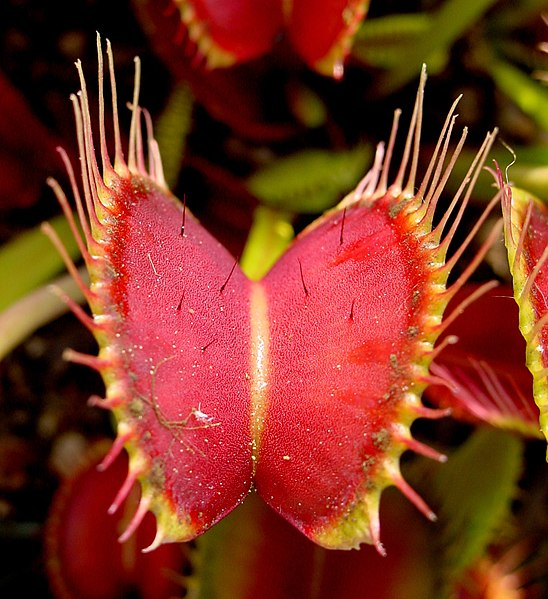
The Venus Flytrap, the most famous of the carnivorous plants. The Venus Flytrap is native to North America- specifically, the Carolinas. If you're interested in them, you should check out @sustainablyyours 's recent post about them- it's actually what inspired me to write this post! [Image source]
Before we get talking about that research, however, let's talk about carnivorous plants themselves. Carnivorous plants are a great example of convergent evolution- that is, evolution producing the same solution multiple times in different evolutionary chains. At least five different orders of flowering plants have evolved the ability to attract and eat animal prey, totaling nearly 600 known predatory plant species. It's a fascinating ecological niche, and it brings up questions of why many more species of plants don't follow that route. Animals are great sources of concentrated nutrients, after all.
It turns out, however, than carnivorous adaptations are evolutionarily and metabolically expensive. Just like a race car or a tank, these powerful adaptations cost a lot of energy to operate. This means that plants without these adaptations tend to outcompete carnivorous plants in most environments, simply beacuse it's cheaper to grow. There is a major exception to that, of course, because otherwise we wouldn't have carnivorous plants. That exception? Nutrient poor environments.
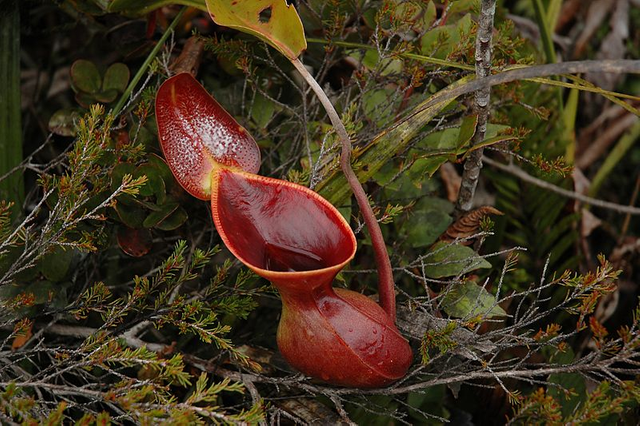
Nepenthes lowii, an endangered species of pitcher plant native to Borneo. It grows in nutrient poor soils atop mountains, and traps prey in its 'pitcher' to absorb their nutrients. Nepenthes lowii can be found both growing on the ground and as an epiphyte, a plant growing on another plant. [Image source]
The environment they appear in most often are bogs- acidic wetlands where calcium and nitrogen are scarce. There's tons of sunlight and water, but little in the way of soil nutrition. Many plants can't survive well in these environments, and mosses and the like tend to dominate. All of a sudden, however, carnivorous plants' expensive adaptations are letting them tower over the mosses and other stumpy plants in bogs, and they tend to have tons of insect prey. So they do great. Thin alpine soils and rocky outcrops are known to be home to carnivorous plants as well.
Not all carnivorous plants are created equal, however. Some carnivorous plants might not have as solid as a claim to the title as others. They might have the adaptations to capture prey, but not digest them well. The appellation is a contentious one for a lot of reasons, not least of which is the fact that there is no strict definition for what makes a plant a carnivore. Regardless of the exact definition, however, alongside the 600 or so identified carnivorous plant species are over 300 protocarnivorous species.
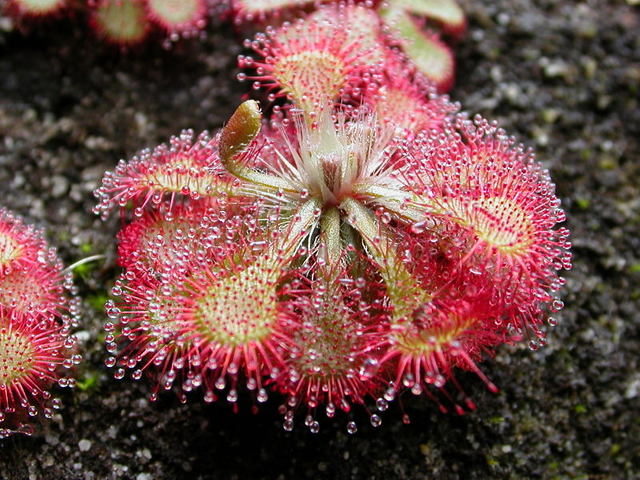
Drosera spatulata, a variety of sundew. Sundews trap insect prey in their sticky leaf 'tentacles', one of which can be seen curled up here. They then digest them in their rolled up tentacles. Sundews are the largest group of carnivorous plants, with nearly 194 species identified. [Image source]
Some of the most interesting examples of 'protocarnivorous' plants number among the pitcher plants. Two species in particular, Sarracenia purpurea and Darlingtonia californica, draw our attention today. Both species actively attract and trap prey, but neither strictly speaking digests them. Instead, they have pools of water inside their pitchers filled with entire functioning ecosystems of bacteria and microinvertebrates that digest and process the insect prey of the plants for them.
Nicholas J. Gotelli, a biologist at the University of Vermont, began a very peculiar experiment using Sarracenia purpurea. While we often think of field biology as a more observational science, many biologists do quite rigorous experiments in the field, Gotelli among them. Gotelli constructed a fascinating experiment revolving around Sarracenia purpurea. More specifically, he developed an experiment revolving around the ecosystems that lived inside its pitchers.
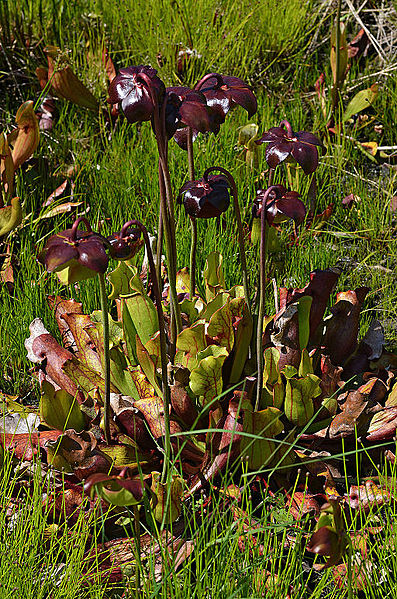
A Sarracenia purpurea, also known as a northern pitcher plant, purple pitcher plant, side saddle flower, or, my favorite, turtle socks. All the flowers and pitchers in the photo belong to a single plant, which can live 30-50 years. The pitchers are actually leaves which have grown and merged together. Sarracenia purpurea is a relatively inefficient capturer of prey, but even with the high escape rate it tends to fill with prey quickly. [Image source]
Gotelli and his team actually did a number of experiments on the plant, all of which were interesting. (High levels of atmospheric nitrogen led to them not even developing pitchers, for instance.) One experiment, however, deserves special interest. Gotelli began adding extra prey to the ecosystems inside the pitcher- effectively, dumping tons of nitrogen into them. The ecosystems did great up until a point, but then they suffered abrupt eutrophic collapse. Their ecosystems spiraled out of control, and the uncontrolled growth stripped all the oxygen out of the water.
Sound familiar? If you've been reading my Changing Face of Our Oceans series here on steemit, you've likely encountered my post on Ocean Dead Zones. Those ocean dead zones are almost identical in nature- massive influxes of nitrogen from agricultural runoff of fertilizers leading to algal blooms that consume all the oxygen from the water. And, in fact, that's exactly what Botelli intended to study. As nitrogen fertilizer use increases, the severity of dead zones will only increase. It turns out that Sarracenia purpurea makes for a fantastic laboratory to study eutrophic collapse, providing a much smaller and more easily altered and observed test site than an oceanic dead zone or even a pond that's undergone the same process.
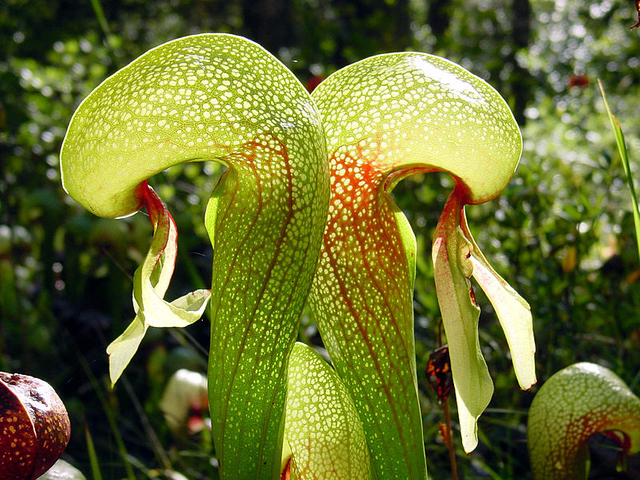
Darlingtonia californica, a pitcher plant native to Northern California and Oregon. It's also known as the cobra lily. Darlingtonia has the same sort of internal digestive ecosystem as Sarracenia purpurea, meaning that it works well for the same sorts of studies. It's a very different pitcher plant in other ways, though. It's considerably more effective at capturing prey- note the transparent 'windows' on the top that confuse prey trying to escape. Unlike other pitcher plants, it doesn't capture rainwater, which would be tricky with the opening on the bottom of the cobra hood structure- instead, it regulates its own internal water level. [Image source]
I actually attended a talk by Botelli at the Oregon Institute for Marine Biology a couple years ago. He was there for a variety of reasons, but one of them was to check out Darlingtonia califonica, a variety of pitcher plants in the region. He'd also been in conversation with biologists studying bromeliads, which while not carnivorous do maintain ecosystems in their internal pools of water. Definitely one of the cooler scientific talks I've been to.
Botelli's experiments illustrate a lot of the more interesting aspects of science in general. While at first his experiments might seem a bit absurd- "You're going to overfeed carnivorous plants? What use is that?" It becomes readily apparent that it's an experiment with significant practical consequences and utility. Therein lies some of the greatest dangers in judging the utility of scientific experiments too early- you never know when researching a question like how jellyfish glow might lead to one of the most important scientific tools of the modern era. On a more ecological level, it illustrates a number of important issues as well- not least of which is that processes we see on the large scale are often seen repeated on a small scale. As above, so below.
Bibliography:
- My written notes from a Nicholas Botelli lecture.
- https://www.uvm.edu/~ngotelli/Bio%20264/Pitcher%20Plant%20Lecture.pdf
- http://www.uvm.edu/~ngotelli/researchpage/Research.html
- https://en.wikipedia.org/wiki/Carnivorous_plant
- https://en.wikipedia.org/wiki/Protocarnivorous_plant
- https://en.wikipedia.org/wiki/Venus_flytrap
- https://en.wikipedia.org/wiki/Drosera
- https://en.wikipedia.org/wiki/Nepenthes_lowii
- https://en.wikipedia.org/wiki/Bog
https://en.wikipedia.org/wiki/Darlingtonia_californica - https://en.wikipedia.org/wiki/Sarracenia_purpurea

You received a 80.0% upvote since you are a member of geopolis and wrote in the category of "ecology".
To read more about us and what we do, click here.
https://steemit.com/geopolis/@geopolis/geopolis-the-community-for-global-sciences-update-4
Being A SteemStem Member
Great post and glad curie liked it. I really wish we had such plants so that the small bugs could have been dealt with.
Now I feel an urge to grow my own carnivorous plants and feed them to death :D
Carnivorous plants are awesome, but also super tricky to grow- Darlingtonia, notably, is often considered one of the single most difficult houseplants to grow. Definitely not for beginners. I keep lots of houseplants, but no carnivorous plants yet.
I did keep Venus fly traps sometimes as a kid, and boy did I love feeding bugs to them.
Yeah I have heard they are hard to grow. Maybe I'll give them a try this year :D
You definitely should! It'd also make for a fun little post series, too.
My wife keeps buying carnivorous plants because she thinks they are really cool, but we have never had any that have survived for more than a few months so far..
Is it known why these plants evolved to consume insects? Was it for benefit of the plant- so it would have greater nutrition sources, or was it due to a need on the forest floor?
Most of them live on mountaintops or in bogs, places where there tends to be very little in the way of nitrogen and other nutrients, which is why they get them from bugs and such.
I had a venus fly trap once... killed it =( Now I want that underwater, suction killer type, you know the one I mean?
I don't, actually! Gonna need to research that now...
This was a very interesting read, @mountainwashere.
It's really kind of strange that feeding them too much nutrients can kill them, but I suppose the nutrient levels they were exposed to would be rather unrealistic to obtain without the help from a scientist.
Yeah, he was a really interesting lecturer, too!
Botelli was thinking on an entirely different level! I never would have thought to use a micro-ecosystem in a pool of water on a plant to model the ocean. That's some good science, right there.
It definitely is!
Lovely thank you @mountainwashere. I was only aware of the Venus.
Ecology, with its phenomena so intimately interwoven with the process of evolution, is an absolutely fascinating field of study! And you guys read and report the symptoms re the self-inflicted demise of this crazy human species with more significant impact that any one else - thanks again...our future is in your hands!
Ecology is a blast! It's the one field that somewhat tempted me away from geology.
To my mind geology is in a sense a subjective investigation of our own ecological niche, in contrast with the objective analyses we do of those of other species. So as a geologist I think you are in fact an ecologist of sorts. A more objective view of our own fragile niche, as you appear to hold, is becoming more imperative, the more we threaten our own existence!
Have u heard of rafflesia? It's the biggest flower in the Borneo Island. Go check it out in google :D
I have, rafflesia is super cool!